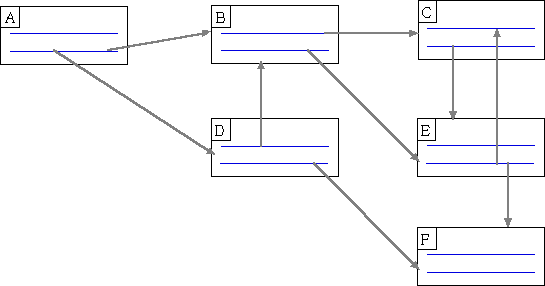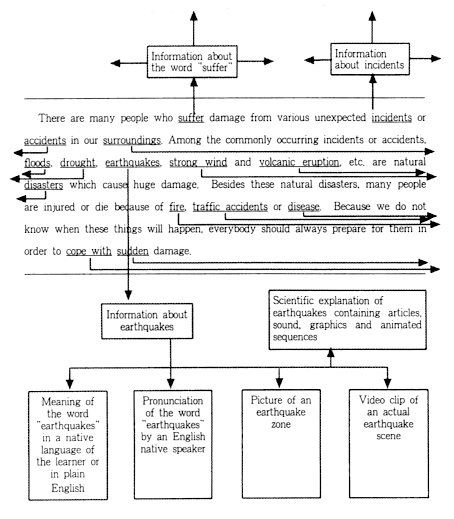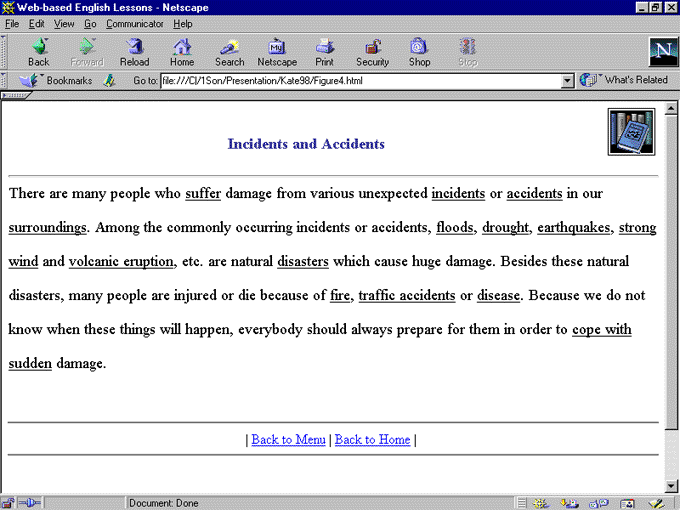
Understanding Hypertext: A Discussion for TEFL
This paper introduces hypertext and describes hyperlinks as a way to seek effective
presentation methods of on-line information that is embedded in hypertext applications.
Hypertext is non-sequential text which is organised to allow readers/users access to
non-linear information. The idea of hypertext first appeared in the 1940s and working
models of hypertext began to take shape from the 1960s. More recently, the development of
hypertext systems has become a critical issue in CALL with the rapid growth of the Internet. The concept of hypertext is quite simple but various claims have been made for it. The paper attempts to define hypertext from a CALL researcher and teacher's point of view and presents an example of a hypertext system for TEFL, while suggesting that we need to know what hypertext exactly means and how it affects language learning and teaching.
I. INTRODUCTION
The use of hyperlinks for a variety of textual, aural and visual supports becomes
vital to computer-assisted language learning (CALL), as is evident in the growing literature
arguing the potential of hypertext/hypermedia (e.g., Ashworth, 1996; Biber, 1992; Fox, 1990;
McVicker, 1992) and in the increasing development of CALL materials employing hyperlinks
(e.g., Donaldson, Haggstrom & Morgan, 1994; Evans, 1993; Hult, Kalaja, Lassila &
Lehtisalo, 1990; Sengupta, 1996). However, hypertext is still unfamiliar to the classroom
practitioner due to the limited availability of hypertext systems and to the fact that the
attention has so far been largely given to media or tools rather than to
This paper is divided into five sections. Following Section One, the introduction,
Section Two defines hypertext and Section Three looks at CALL researchers' discussions on
hypertext approaches. Section Four presents an example of a hypertext system for teaching
English as a foreign language (TEFL) and Section Five concludes with implications for the
development and use of hypertext in TEFL and directions for future research endeavors.
II. CONCEPTS OF HYPERTEXT
It is generally accepted that the idea of hypertext was first described and published in 1945, when Bush (1945) proposed a system called Memex in his article. In 1965, the term "hypertext" was coined by Nelson who had a visionary idea of a system called Xanadu (Nelson, 1981). Other early hypertext systems developed by computer specialists include Hypertext Editing System (1967) from Brown University, ZOG (1972) from Carnegie-Mellon University, NoteCards (1985) from Xerox PARC, and Intermedia (1985) from Brown University. Guide (1986), developed at the University of Kent in the UK and introduced by Office Workstations Limited, was the first commercial product to run on microcomputers. In 1987, HyperCard, the most widely known hypertext authoring system, was announced by Apple Computer. Because of its ease of use and the widespread use of Macintosh computers, HyperCard gained popularity and many instructional designers have found it very useful for developing computer-based training materials. More recently, the concepts of hypertext have had considerable adaptation and reshaping with the advent of multimedia PC and the rapid growth of the Internet, particularly the World Wide Web utilizing hyperlinks for the presentation of non-linear information.
After Nelson (1981) described hypertext as "non-sequential writing", a number of
researchers (e.g., Berk & Devlin, 1991; Carr, 1988; Conklin, 1987; Jonassen, 1991;
Nielsen, 1990; Rubens, 1989; Seyer, 1991; Slatin, 1991; Tolhurst, 1992, 1995; Yang, 1996),
mainly in the field of applied computer
Simply, hypertext is non-sequential text which is organised to allow readers/users
access to non-linear information. The basic units of information are called nodes
and the ways of establishing and indicating the possible connections between the nodes are
called links. A hypertext link connects an anchor node with a destination node and
is often associated with specific parts of any of the nodes. Figure 1, which is a modified
view of Nielsen (1990, p. 1), shows a small hypertext structure which has six nodes and
nine links. Once users start by reading the text marked A, the hypertext structure gives
two options: B or D. Assuming that users decide to go to B, they can then jump to C or to
E, and from E they can go to C or to F. Many more different paths, of course, can be
created than the paths this example shows.
FIGURE 1

When referring to systems that include a variety of non-textual node types such as graphics, sound, and moving images, people frequently use the term "hypermedia" instead of hypertext. Hypermedia can be defined as the combination of hypertext and multimedia. In hypermedia applications, we can access and link together a rich collection of multimedia resources (Ashworth, 1996; Barker, 1993; Nielsen, 1990; Picher, Berk, Devlin & Pugh, 1991; Seyer, 1991). Hypermedia implies managing and retrieving information from multimedia databases and allows users to choose their own non-linear paths through text, graphics, audio and video. Empowered by hypermedia, we can create and explore flexible information structures using interactive selection strategies in electronic networks.
The most distinctive feature of hypertext is the users' freedom to explore banks of information (McAleese, 1989). Users can take control of a set of dynamic links in obtaining non-linear information of the hypertext system. They are allowed to browse and navigate by means of the links set up by the author of the system. This reflects the fact that the author of hypertext can determine the numbers of the possible links. At this point, Gilster (1997) argues that the author of hypertext should think critically about the routes users will be allowed to select. In the creation of hypertext, therefore, the author's critical judgments need to be applied as well as his/her technical knowledge.
On the other hand, one of the possible problems of hypertext is that users may become
disoriented and lost in the network of nodes (Conklin, 1987; Edwards & Hardman, 1989;
Seyer, 1991). Due to the complexity of hypertext structures, the users might have
difficulties in understanding where they are and in deciding where to go next. The hypertext
system, therefore, needs to provide a clear access structure and means for recovery to help
the users through interactive information-seeking activities. In other words, hypertext
should offer a supportive environment in which the users can access and retrieve
information, find their own paths while browsing and navigating, and expand webs of
information without getting lost in working through it.
III. HYPERTEXT IN CALL RESEARCH
The potential of hypertext/hypermedia has been considerably discussed in CALL
research. Biber (1992) comments on the use of hypertext as follows:
Hypertext/hypermedia is one of the five approaches to reading with the computer suggested by McVicker (1992). Other types of approaches include authoring systems, text processing systems, interactive fiction and the Internet. Fox (1990) considers hypertext approaches to reading skills as a promising aid for second language learning. With a focus on multimedia resources, Ashworth (1996) notes, "Hypermedia has the obvious advantage that its linkages can be used to support reading in a foreign language. Words or larger pieces of text can be glossed in pop-up windows, the text can be pronounced in digitized voice; and meaning can be illustrated with pop-up graphics, animated sequences, and video clips" (p. 86). Ashworth also indicates that hypermedia plays the role of a new medium for developing instructional programs and the role of a new communications medium in networks.
Based on the ideas of hypermedia, Hult et al. (1990) present a microcomputer program called HyperReader. Their software system uses the hypertext paradigm in the design of its user-interface and its operation. Evans (1993) describes a HyperCard program entitled Nicolas incorporating text, graphics and sound for use by students of French at intermediate level. His records of student performance in the frequency of access to dictionary support show that the French definitions were accessed most often, followed by sound, picture, and then the English glossary. Evans also notes, "The integration of text, sound and visual data clearly is of great benefit to the learner as this will reinforce comprehension, pronunciation and contextual use in a way that traditional materials are not able to do" (pp. 214-215).
In summary, a number of CALL studies suggest that the use of hypertext has great
potential in language learning and that hypertext/hypermedia
IV. AN EXAMPLE OF A HYPERTEXT SYSTEM
This section gives an idea of the construction of a hypertext application for English language teaching. Figure 2, which is a modified display of Barker (1993, p. 52), shows the design of reactive areas within a section of hypertext. A reactive area can be selected and activated by the user by pointing and clicking operations. Each button or hotspot, which is a visual cue in a node, is usually linked to other information units and has its own embedded links. In Figure 2, the 'incidents' hotspot is associated with supplementary information elements which give further information about incidents. Similarly, the 'earthquakes' hotspot gives the user more information about earthquakes by linking to various types of media such as text, graphics, sound, video, etc.
The linked pieces of information can be displayed as a pop-up window or as a separate
page on the same or different screen. Hypertext systems can make an explanation of any word
pop up in a separate window when learners click on any word that they find unfamiliar. In a
similar way with multimedia, hypertext systems can also make a visual context cue come out
in a separate page when learners click on a certain button that provides background
information of a reading text. In doing so, the systems allow learners themselves to decide
how much help they will need and where they will finish their exploration in relation to
the specific word or text. This kind of function, supported by dynamic glossaries and
on-line help, may facilitate the reading process in a foreign language tutorial.
FIGURE 2

With regard to CALL applications, the example shown in Figure 2 can be embodied into
the format of courseware or the World Wide Web (subsequently "the Web") documents. Figure 3
shows a screen shot from hypertext-based courseware developed by using SuperCard as
an authoring tool. It includes buttons and icons for using an electronic glossary and an
option to record the
FIGURE 3

Figure 4 gives a screen shot from a page representing hyperlinks in a Web browser
called Netscape. It displays a network of nodes in a hypertext document created by
using HTML (HyperText Markup Language). Each node is linked to an on-line dictionary or
another page which guides the learner to references for further information on the selected
item.
FIGURE 4

V. CONCLUSIONS AND IMPLICATIONS
This paper has presented general concepts of hypertext and demonstrated the
connections between hypertext and foreign language learning. An example of a simple
hypertext system for TEFL has been described in terms of hypertext structures and formats.
As discussed in the paper, hypertext can assist language learning because of its linking
abilities. Hypertext makes CALL work actively by allowing and encouraging learners to
manage the learning process independently and to explore linked pieces of information
non-sequentially on the basis of their personal preferences and needs. It also provides
immediate access to dictionaries or references through implicit links from any text. Each
learner can have the option to link either to an explanation of any word or to various
types and sources of information on particular items as much of the target material as
required or desired by the learner. A reference tool such as an
Increasing effort is now being made to make the use of hypertext effective in foreign language instruction with new developments in software and hardware technology. Creating a hypertext application, however, is much more time-consuming and difficult than producing a traditional CALL program because the author needs to provide sufficient links to support the learner's specific tasks in instructional activities that are built into a hypertext-based program. For this reason, relatively few attempts to design hypertext applications have been made by CALL practitioners, despite the widespread attention given to hypertext systems. The technical expertise needed to develop a hypertext system is certainly important throughout ongoing programming and software and hardware operating. Unless the teacher has programming skills and essential tools for designing a piece of hypertext-based courseware or hyperdocuments, basic requirements such as technical support from a group of developers, stand-alone versions of hypertext applications, or teacher training for implementing hypermedia need to be fulfilled in order to improve the accessibility and usability of hypertext systems.
Although the evaluation of hypertext systems is surely necessary, only few studies
(e.g., Edmonds, 1997; Hulstijn, 1993) have discussed the effects of the use of hypertext
in English language education. The effectiveness of hypertext/hypermedia applications for
TEFL has to be established in ways that integrate pedagogical objectives and technological
aspects. The evaluation needs to check whether the hypertext system is easy to use and is
also pleasant to learn through exploring electronic texts. While searching for appropriate
contents and presentation methods of hypertext, empirical research should look at specific
features of the hypertext system such as the learner's performance and perceptions on the
use of hypertext as well as the retrieval time of databases and the selection of reactive
areas. Further research is required to investigate the specific ways that hypertext can
assist better learning in a language course and ways to incorporate hypertext/hypermedia
with intelligent tutoring systems. All these research efforts, of course, need to start
from the understanding of the nature of hypertext. It is likely that the emergence of
effective hypertext systems will contribute increasingly to EFL instruction and research
in CALL environments.
REFERENCES
Armstrong, K. M., & Yetter-Vassot, C. (1994). Transforming teaching through technology. Foreign Language Annals, 27, 475-486.
Ashworth, D. (1996). Hypermedia and CALL. In M. C. Pennington (Ed.), The power of CALL (pp. 79-95). Houston, TX: Athelstan.
Barker, P. (1993). Exploring hypermedia. London: Kogan Page.
Berk, E., & Devlin, J. (1991). What is hypertext?. In E. Berk & J. Devlin (Eds.), Hypertext/Hypermedia handbook (pp. 3-7). New York: Intertext.
Biber, D. (1992). Applied linguistics and computer applications. In W. Grabe & R. B. Kaplan (Eds.), Introduction to applied linguistics (pp. 257-278). Reading, MA: Addison-Wesley.
Bush, V. (1945). As we may think. Atlantic Monthly, 176(1), 101-108.
Carr, C. (1988). Hypertext: A new training tool?. Educational Technology, 28(8), 7-11.
Conklin, J. (1987). Hypertext: An introduction and survey. IEEE Computer, 20(9), 18-41.
Cobb, T., & Stevens, V. (1996). A principled consideration of computers and reading in a second language. In M. C. Pennington (Ed.), The power of CALL (pp. 115-136). Houston, TX: Athelstan.
Donaldson, R. P., Haggstrom, M. A., & Morgan, L. Z. (1994). Reading is creative, too! A discussion of two hypercard stacks which can facilitate second-language reading comprehension. Computer Assisted Language Learning, 7, 195-208.
Edmonds, S. (1997, March). Making sense of hypertext. Paper presented at CAL 97, University of Exeter, UK.
Edwards, D. M., & Hardman, L. (1989). 'Lost in hyperspace': Cognitive mapping and navigation in a hypertext environment. In R. McAleese (Ed.), Hypertext: Theory into practice (pp. 105-125). Norwood, NJ: ABLEX.
Evans, M. (1993). Nicolas: Using HyperCard with intermediate level French learners. System, 21, 213-229.
Fox, J. (1990). A microcomputer-based approach to training in second language reading skills. Computer Assisted Language Learning, 1, 29-40.
Gilster, P. (1997). Digital literacy. New York: John Wiley & Sons.
Hulstijn, J. (1993). When do foreign-language readers look up the meaning of unfamiliar words? The influence of task and learner variables. Modern Language Journal, 77, 139-147.
Hult, S., Kalaja, M., Lassila, O., & Lehtisalo, T. (1990). HyperReader - An interactive course in reading comprehension. System, 18, 189-198.
Jonassen, D. H. (1991). Hypertext as instructional design. Educational Technology Research and Development, 39(1), 83-92.
McAleese, R. (1989). Navigation and browsing. In R. McAleese (Ed.), Hypertext: Theory into practice (pp. 6-44). Norwood, NJ: ABLEX.
McVicker, J. (1992). Several approaches to computer-based reading study. CAELL Journal, 3(4), 2-11.
Nelson, T. H. (1981). Literary machines. Swathmore, PA: Author.
Nielsen, J. (1990). Hypertext and hypermedia. San Diego, CA: Academic Press.
Picher, O., Berk, E., Devlin, J., & Pugh, K. (1991). Hypermedia. In E. Berk & J. Devlin (Eds.), Hypertext/Hypermedia handbook (pp. 23-52). New York: Intertext.
Rubens, P. (1989). Online information, hypermedia, and the idea of literacy. In E. Barrett (Ed), The society of text: Hypertext, hypermedia, and the social construction of information (pp. 3-21). Cambridge, MA: The MIT Press.
Sengupta, S. (1996). Creating a hypertext database to help Hong Kong English language teachers teach writing. System, 24, 187-198.
Seyer, P. (1991). Understanding hypertext: Concepts and applications. Blue Ridge Summit, PA: Windcrest Books.
Slatin, J. M. (1991) Composing hypertext: A discussion for writing teachers. In E. Berk & J. Devlin (Eds.), Hypertext/Hypermedia handbook (pp. 55-64). New York: Intertext.
Tolhurst, D. (1992). A checklist for evaluating content-based hypertext computer software. Educational Technology, 32(3), 17-21.
Tolhurst, D. (1995). Hypertext, hypermedia, multimedia defined?. Educational Technology, 35(2), 21-26.
Yang, S. C. (1996). Designing instructional applications using constructive hypermedia.
Educational Technology, 36(6), 45-50.